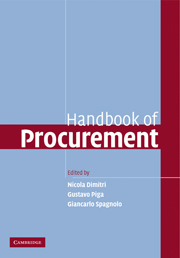Book contents
- Frontmatter
- Contents
- List of figures
- List of tables
- List of contributors
- Preface
- Part I Preliminary Issues
- Part II General Strategic Principles
- Part III Competitive Tendering Strategies
- Part IV Attracting and Screening Participants
- Part V Preventing Collusion and Corruption
- Part VI Dynamic Forces and Innovation
- 17 Managing dynamic procurements
- 18 Designing reputation mechanisms
- 19 Procuring innovations
- Glossary
- Index
- References
17 - Managing dynamic procurements
Published online by Cambridge University Press: 04 November 2009
- Frontmatter
- Contents
- List of figures
- List of tables
- List of contributors
- Preface
- Part I Preliminary Issues
- Part II General Strategic Principles
- Part III Competitive Tendering Strategies
- Part IV Attracting and Screening Participants
- Part V Preventing Collusion and Corruption
- Part VI Dynamic Forces and Innovation
- 17 Managing dynamic procurements
- 18 Designing reputation mechanisms
- 19 Procuring innovations
- Glossary
- Index
- References
Summary
Introduction
Recently we considered which laptop computer to purchase for the new and returning faculty at our business school. The choice was between an old proven brand that we had been using and a new brand that was attractively priced but unfamiliar to our people. The old brand was reliable but it had not been updated much recently, whereas the new brand incorporated some advanced technology and attractive design features. Overall the new brand seemed like a better buy than the old one. But, there was a cost to switching from the old to the new brand. We would have to learn new skills to operate the new brand and our technicians would need additional training to repair and service the new machines.
We decided after much deliberation to remain with the old brand. The cost of switching computers was too high. We realized the school had become so dependent on the old technology that we were locked in. Switching to a new one was not feasible, at least not in short run. But, this was just the tip of the iceberg. We discovered there were many more products and services that we were locked into buying, including computer software, reproduction equipment, communication services, and information technology. In each case, we would need to retrain our employees and adjust our operating procedures to switch products.
- Type
- Chapter
- Information
- Handbook of Procurement , pp. 433 - 445Publisher: Cambridge University PressPrint publication year: 2006
References
- 1
- Cited by



